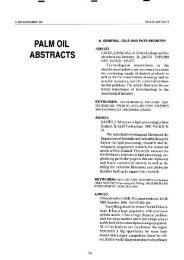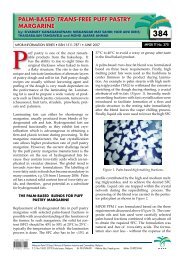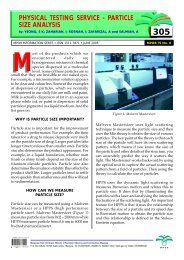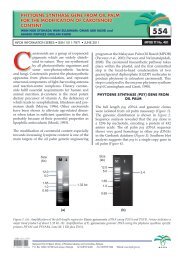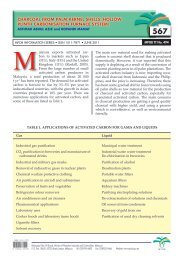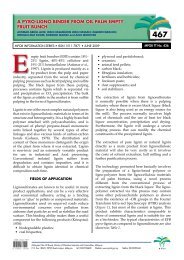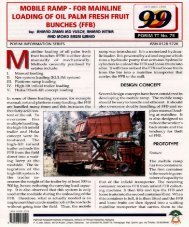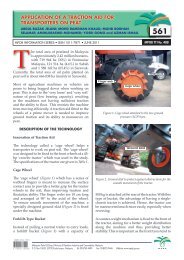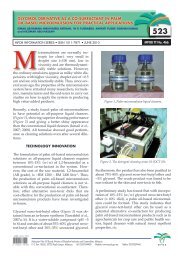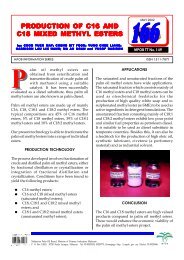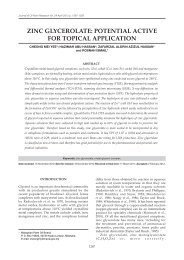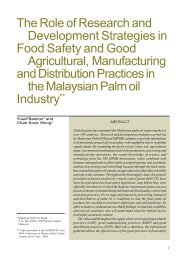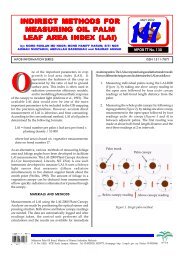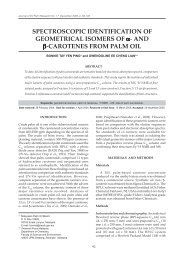production of palm-based tocotrienols-enhanced fraction (tef)
production of palm-based tocotrienols-enhanced fraction (tef)
production of palm-based tocotrienols-enhanced fraction (tef)
You also want an ePaper? Increase the reach of your titles
YUMPU automatically turns print PDFs into web optimized ePapers that Google loves.
PRODUCTION OF PALM-BASED<br />
TOCOTRIENOLS-ENHANCED FRACTION (TEF)<br />
by: AB GAPOR MD TOP<br />
287<br />
MPOB INFORMATION SERIES • ISSN 1511-7871 • JUNE 2005 MPOB TT No. 290<br />
Tocotrienols as well as tocopherols are<br />
homologues <strong>of</strong> vitamin E. Vitamin E is a fatsoluble<br />
natural antioxidant and present<br />
in small amount in vegetable oils and fats.<br />
The importance <strong>of</strong> vitamin E, an essential<br />
vitamin, for keeping the good health in animals and<br />
human has long been recognized. Deficiency <strong>of</strong><br />
vitamin E in animals would lead to complications,<br />
such as foetal resorption and muscular dystrophy.<br />
Although α-tocopherol is the most active form <strong>of</strong><br />
vitamin E in terms <strong>of</strong> foetal resorption tests, it is<br />
interesting to note that progress on research over the<br />
last few years indicates that <strong>tocotrienols</strong> form <strong>of</strong><br />
vitamin E are superior than α-tocopherol in activities<br />
such as hypocholesterolemic and anti-cancer effects.<br />
In order to harness the full benefits <strong>of</strong> <strong>tocotrienols</strong>,<br />
there is a need for <strong>tocotrienols</strong> preparation with<br />
minimal amount <strong>of</strong> tocopherols in it. Almost all<br />
current <strong>tocotrienols</strong> preparations in the market<br />
contain tocopherols, for instance Palm Vitamin E, a<br />
<strong>tocotrienols</strong>-rich <strong>fraction</strong> (TRF) is a mixture <strong>of</strong><br />
<strong>tocotrienols</strong> and tocopherols at a typical ratio <strong>of</strong> 75<br />
to 25. A process for preparing <strong>tocotrienols</strong>-<strong>enhanced</strong><br />
<strong>fraction</strong> (TEF) products with a ratio <strong>of</strong> <strong>tocotrienols</strong><br />
to tocopherols more than 90:10 is presented.<br />
PRODUCTION OF TEF<br />
The current sources for extraction <strong>of</strong> <strong>tocotrienols</strong> are<br />
from agro-<strong>based</strong> industries including <strong>palm</strong> oil and<br />
rice bran oil. TRF preparations are available in the<br />
market, for example at 20%, 50% and 70% total<br />
vitamin E content, with a typical ratio <strong>of</strong> <strong>tocotrienols</strong><br />
to tocopherols at 75:25. We propose a technology for<br />
increasing the content <strong>of</strong> <strong>tocotrienols</strong> to more than<br />
80% and improving the ratio <strong>of</strong> <strong>tocotrienols</strong> to<br />
tocopherols to 90:10 or more. An example is the<br />
<strong>production</strong> <strong>of</strong> MPOB-T3Mix88, a TEF from <strong>palm</strong> fatty<br />
acid distillate (Figure 1). The process involves the<br />
preparation <strong>of</strong> <strong>palm</strong>-<strong>based</strong> TRF and subsequently<br />
extraction <strong>of</strong> tocopherol resulting in an increase <strong>of</strong><br />
<strong>tocotrienols</strong> content from 57.3% to 88.0% and the ratio<br />
<strong>of</strong> <strong>tocotrienols</strong> to tocopherols from 76:24 to 97:3<br />
(Table 1). Another product, MPOB-T3 Mix 50<br />
Vitamin E<br />
Concentration<br />
0.4%-0.8% Palm fatty<br />
acid distillate<br />
0.4%-0.8% Methyl esters<br />
Figure 1. Production <strong>of</strong> <strong>palm</strong>-<strong>based</strong> <strong>tocotrienols</strong><strong>enhanced</strong><br />
<strong>fraction</strong> (TEF).<br />
Malaysian Palm Oil Board, Ministry <strong>of</strong> Plantation Industries and Commodities, Malaysia<br />
P. O. Box 10620, 50720 Kuala Lumpur, Malaysia. Tel: 03-89259155, 89259775, Website: http://mpob.gov.my Telefax: 03-89259446<br />
▼<br />
▼<br />
5%-10% Distillation<br />
residue<br />
▼<br />
60%-80% Tocotrienols-<br />
Rich Fraction<br />
(TRF)<br />
▼<br />
>80% Tocotrienols-<br />
Enhanced Fraction<br />
(TEF)<br />
ESTERIFICATION<br />
DISTILLATION<br />
➔ Distilled<br />
Methyl esters<br />
CONCENTRATION<br />
TOCOPHEROL<br />
ISOLATION
TABLE 1. TOCOPHEROLS AND TOCOTRIENOLS CONTENT OF<br />
TOCOTRIENOLS PREPARATIONS<br />
Tocotrienols α-Tocopherol α-Tocotrienol γ-Tocotrienol δ-Tocotrienol Total<br />
Preparation (%) (%) (%) (%) (%)<br />
Palm Vitamin E 17.8 17.1 23.0 17.2 75.1<br />
(TRF)<br />
MPOB-T3 Mix88 2.6 25.2 37.9 24.9 90.6<br />
(TEF)<br />
MPOB-T3 Mix50 1.5 14.6 21.6 14.8 52.5<br />
Notes: TRF = <strong>tocotrienols</strong>-rich <strong>fraction</strong>.<br />
TEF = <strong>tocotrienols</strong>-<strong>enhanced</strong> <strong>fraction</strong>.<br />
(Figure 2) with <strong>tocotrienols</strong> content 51% is prepared<br />
by blending MPOB-T3Mix88 with RBD <strong>palm</strong> olein<br />
accordingly. The product (MPOB-T3 Mix50) with a<br />
minimal <strong>tocotrienols</strong> content <strong>of</strong> 50%, can be easily<br />
promoted for various applications.<br />
Figure 2. Palm-<strong>based</strong> <strong>tocotrienols</strong> (MPOB-T3Mix50).<br />
POTENTIAL BENEFITS OF TOCOTRIENOLS<br />
Both tocopherols and <strong>tocotrienols</strong> are known for their<br />
antioxidant activities in foods and biological systems<br />
(Ab Gapor et al., 1989; Minhajuddin et al., 2005).<br />
α-Tocotrienol showed better antioxidant activity than<br />
α-tocopherol in the order <strong>of</strong> 40-60 times against lipid<br />
peroxidation (Serbinova et al., 1991). In a human<br />
study, O’Byrne et al. (2000) reported that α-tocotrienol<br />
may be potent in decreasing low-density lipoprotein<br />
(LDL) oxidizability. Tocotrienols have been shown<br />
to be a potential hypocholesterolemic agent (Qureshi<br />
et al., 1995; Hasselwander et al., 2002). Tocotrienols<br />
have also been shown to have anti-cancer activities<br />
(Kato et al., 1985; Komiyama et al., l989; Wan Ngah et<br />
al., 1999; Nesaretnam et al., 2000). The superiority <strong>of</strong><br />
<strong>tocotrienols</strong> over tocopherols in anti-cancer effects<br />
have been confirmed (Guthrie et al., 1997; Yu et al.,<br />
1999; McIntyre et al., 2000; Yu et al., 2003). Tocotrienols<br />
have been reported to show anti-angiogenic activity,<br />
suggesting potential usefulness as a therapeutic<br />
agent for tumour angiogenesis (Miyazawa et al.,<br />
2004). α-Tocotrienol but not tocopherols has been<br />
shown to be a potent neuroprotection agent (Sen et<br />
al., 2000; Osakada et al., 2004). Anderson et al. (2003)<br />
reported that <strong>tocotrienols</strong> induce IKBKAP<br />
expression, thus suggesting a possible therapy for<br />
familial dysautonomia.<br />
CONCLUSION<br />
A substantial amount <strong>of</strong> evidence indicates that<br />
<strong>tocotrienols</strong> are more effective than tocopherols in health<br />
promoting activities including hypocholesterolemic,<br />
anti-cancer and antioxidant properties. Technology<br />
for producing TEF is available for further<br />
development. The products are expected to have<br />
applications in the high end nutraceuticals,<br />
functional foods and cosmetics industries.<br />
ACKNOWLEDGEMENT<br />
The author would like to thank the management <strong>of</strong><br />
MPOB especially its Director-General for their<br />
encouragement and support. Many thanks are also<br />
due to Meriam Hassan and Mahani Rifaeh for their<br />
excellent technical assistance.
REFERENCES<br />
AB GAPOR MD TOP; ONG, A S H; KATO, A;<br />
WATANABE, H and KAWADA, T (1989).<br />
Antioxidant activities <strong>of</strong> <strong>palm</strong> vitamin E with special<br />
reference to <strong>tocotrienols</strong>. Elaeis, 1(1): 63-67.<br />
ANDERSON, S L; QUI, J and RUBIN, B Y ( 2003).<br />
Tocotrienols induce IKBKAP expression: a possible<br />
therapy for familial dysautonomia. Biochem Biophys<br />
Res Comm, 306: 303-309.<br />
GUTHRIE, N; GAPOR, A; CHAMBERS, A F and<br />
CARROLL, K K (1997). Inhibition <strong>of</strong> proliferation <strong>of</strong><br />
estrogen receptor-negative MDA-MB-435 and<br />
-positive MCF-7 human breast cancer cells by <strong>palm</strong><br />
oil <strong>tocotrienols</strong> and tamoxifen, alone and in<br />
combination. J. Nutr., 127(3): 544S-548S.<br />
HASSELWANDER, O; KRAMER, K; HOPPE, P P;<br />
OBERFRANK, U; BALDENIUS, K; SCHRODER, H;<br />
KAUFMANN, W; BAHNEMANN, R and<br />
NOWAKOWSKY, B (2002). Effects <strong>of</strong> feeding various<br />
tocotrienol sources on plasma lipids and aortic<br />
atherosclerotic in cholesterol-fed rabbits.<br />
Fd. Res. Intern., 35: 245-251.<br />
KATO, A; YAMAOKA, M; TANAKA, A;<br />
KOMIYAMA, K and UMEZAWA, I (1985).<br />
Physiological effect <strong>of</strong> tocotrienol. J. Japan Oil Chem.<br />
Soc. (YUKUGAKU), 34: 375-376.<br />
KOMIYAMA, K; IIZUKA, K; YAMAOKA, M;<br />
WATANABE, H; TSUCHIYA, N and UMEZAWA, I<br />
(1989). Studies on the biological activity <strong>of</strong><br />
<strong>tocotrienols</strong>. Chem. Phar. Bull., 37(5): 1369-1371.<br />
MCINTYRE, B S, BRISKI, K P; TIRMENSTEIN, M<br />
A; FARISS, M W; GAPOR, A and SYLVESTER, P W<br />
(2000). Antiproliferative and apoptotic effects <strong>of</strong><br />
tocopherols and <strong>tocotrienols</strong> on normal mouse<br />
mammary epithelial cells. Lipids, 35(2): 171-180.<br />
MINHAJUDDIN, M; BEG, Z H and IQBAL, J ( 2005).<br />
Hypolipidemic and antioxidant properties <strong>of</strong><br />
tocotrirnol rich <strong>fraction</strong> isolated from rice bran oil in<br />
experimentally induced hyperlipidemic rats. Fd Chem<br />
Toxico, 43: 747-753.<br />
MIYAZAWA, T; INOKUCHI, H; HIROKANE, H;<br />
TSUZUKI, T; NAKAGAWA, K and IGARASHI, M<br />
(2004). Anti-angiogenic potential <strong>of</strong> tocotrienol in<br />
vitro. Biochemistry (Moscow), 69(1): 67-69.<br />
NESARETNAM, K; DORAISAMY, S and DARBRE,<br />
P D ( 2000). Tocotrienols inhibit growth <strong>of</strong> ZR-75-1<br />
breast cancer cells. Internat. J. Fd. Sci. Nut., 5: S95-<br />
S103.<br />
O’BYRNE, D; GRUNDY, S; PACKER, L; DEVARAJ,<br />
S; BALDENIUS, K; HOPPE, P P; KRAEMER, K;<br />
JIALAL, I and TRABER, M G ( 2000). Studies <strong>of</strong><br />
LDL oxidation following α-, γ- and δ-tocotrienol<br />
acetate supplementation <strong>of</strong> hypercholesterolemic<br />
humans. Free Radical Biology & Medicine, 29(9): 834-<br />
845.<br />
OSAKADA, F; HASHINO, A; KUME, T; KATSUKI,<br />
H; KANEKO, S and AKAIKE , A (2004). α-Tocotrienol<br />
provides the most potent neuroprotection among<br />
vitamin E analogs on cultured striatal neurons.<br />
Neuropharmacology, 447: 904-915.<br />
QURESHI, A A; BRADLOW, B A; BRACE, L;<br />
MANHANDLE, J; PETERSON, D M; PEARCE, B C;<br />
WRIGHT, J K; GAPOR, A and ELSON, C E (1995).<br />
Response <strong>of</strong> hypercholesterolemic subjects to<br />
administration <strong>of</strong> <strong>tocotrienols</strong>. Lipids, 30 (12): 1171-<br />
1177.<br />
SEN, C K; KHANNA, S; ROY, S and PACKER, L<br />
(2000). Molecular basis <strong>of</strong> vitamin E action. J. Bio.<br />
Chem., 275( 17): 13049-13055.<br />
SERBINOVA, E; KAGAN,V; HAN, D and PACKER,<br />
L (1991). Free radical recycling and intramembrane<br />
mobility in the antioxidant properties <strong>of</strong> alphatocopherol<br />
and alpha-tocotrienol. Free Radical Biology<br />
& Medicine, 10: 263-275.<br />
YU, W; SIMMONS-MENCHACHA, M; GAPOR, A;<br />
SANDERS, B G and KLINE, K (1999). Induction <strong>of</strong><br />
apoptosis in human breast cancer cells by<br />
tocopherols and <strong>tocotrienols</strong>. Nutrition and Cancer,<br />
33(1): 26-32.<br />
YU, F L; GAPOR, A and BENDER, W ( 2003).<br />
Evidence for the preventive effect <strong>of</strong> the<br />
polyunsaturated phytol side chain in <strong>tocotrienols</strong> on<br />
17b-estradiol epoxidation. Paper presented at PIPOC<br />
2003 International Palm Oil Congress β- Food<br />
Technology and Nutrition Conference. 24-28 August<br />
2003. Putrajaya Marriott Hotel.<br />
WAN NGAH, W Z; AZIAN, A L; NARIMAH, A H<br />
H; PERMEEN, Y; NASARUDDIN, A; AB GAPOR,<br />
M T; MAZLAN, Z and KHALID, B A K (1999).<br />
Palmvitee supplementation <strong>of</strong> chronic hepatits B<br />
patients and in vitro studies on cancer cell lines. Proc.<br />
<strong>of</strong> the 1999 PORIM International Palm Oil International<br />
Congress - Nutrition Congress. p. 233-240.
For more information kindly contact:<br />
Director-General<br />
MPOB<br />
P. O. Box 10620<br />
50720 Kuala Lumpur, Malaysia.<br />
Tel: 03-89259155, 89259775<br />
Website: http://mpob.gov.my<br />
Telefax: 03-89259446



